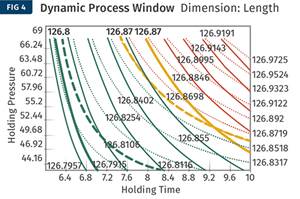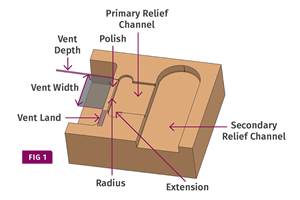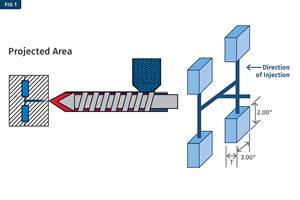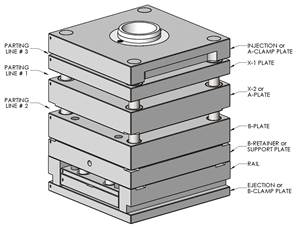Get Custom Hot Halves in a Hurry
If you need a complete bolt-on hot-runner system on short notice, and off-the-shelf systems come up short in design flexibility, there's a solution available from Husky Injection Molding Systems of Milton, Vt.
If you need a complete bolt-on hot-runner system on short notice, and off-the-shelf systems come up short in design flexibility, there's a solution available from Husky Injection Molding Systems of Milton, Vt. The company's new Pronto hot-runner systems straddle the line between custom-engineered and stock systems, providing both design flexibility and drastically reduced price and delivery time. According to Charles Hillman, general manager of Husky's hot-runner 911±¬ÁĎÍř, Pronto hot halves cost about 20% less than the company's custom systems and offer a four-week delivery time.
Husky trimmed prices and lead times by pegging Pronto hot-half designs to standard D-M-E and National Tool mold-base sizes and by imposing some limits on component placement and mold-interface choices. This moderate level of standardization enables Husky to automate much of system design and cut engineering time to a few minutes. In all other ways, Pronto hot halves are identical to Husky's custom systems. "Pronto is not really a standardized product but a configurable product within a few guidelines," explains sales manager David Whiffen.
Like Husky's custom systems, Pronto hot halves offer infinitely variable pitch spacing within the envelope defined by the nozzle and plate size. They also undergo the same review process, in which Husky engineers perform a flow analysis, size the heaters, and optimize the gates. The plates are stainless steel and are built with a form-fitting full pocket for the manifold. And they carry the same three-year mechanical, "no leak," and electrical warrantees.
Some limitations apply
For now, the Pronto program consists only of two- and four-drop systems using the company's 750 Series nozzle. It has a diameter of roughly 3/4 in. and three different melt-channel sizes to cover a shot-size range from 2 to 250 g. Over the next year, Husky plans to add an eight-drop version and systems based on Hasco mold-base sizes.
The few design constraints on the semi-standardized Pronto systems ensure that the hot runners do not interfere with features of the standard mold bases. For example, guide pins, interface taps, sprue and electrical-connector locations are all fixed on the Pronto. Manifold alignment is also limited somewhat: The two-drop system comes only in a horizontal orientation. The four-drop is available with only square or rectangular layout.
Pronto can't accommodate tools whose cavities require a non-uniform "L dimension" (the distance from the front of the hot runner to the cavity). And it doesn't support edge gates or multi-tip probes.
While these limitations may rule out a few applications
That view is echoed by Bob Everhart, project engineer for the first Pronto customer, Advance Dial Co., a toolmaker and molder in Elmhurst, Ill. Advanced Dial recently ordered the system for a Motorola cell-phone-housing tool. Everhart notes that users of D-M-E or National mold-base sizes have almost no concessions to make. "You can't angle runners to get the parts a little closer together," he concedes, adding that it's an acceptable price to pay for speed. "The biggest attraction for us was lead time. We've had trouble finding quality suppliers who could meet a four- or five-week lead time," he says.
Husky's new version of its electronic catalog contains all the information needed to configure a Pronto system and submit the order by e-mail. The program lets users merge a custom manifold design with the standard plate size. It even has a built-in calculator that lets users account for thermal effects when specifying the nozzle length.
Related Content
Optimizing Pack & Hold Times for Hot-Runner & Valve-Gated Molds
Using scientific procedures will help you put an end to all that time-consuming trial and error. Part 1 of 2.
Read MoreBack to Basics on Mold Venting (Part 2: Shape, Dimensions, Details)
Here’s how to get the most out of your stationary mold vents.
Read MoreIs There a More Accurate Means to Calculate Tonnage?
Molders have long used the projected area of the parts and runner to guesstimate how much tonnage is required to mold a part without flash, but there’s a more precise methodology.
Read MoreHow to Design Three-Plate Molds, Part 1
There are many things to consider, and paying attention to the details can help avoid machine downtime and higher maintenance costs, and keep the customer happy.
Read MoreRead Next
For PLASTICS' CEO Seaholm, NPE to Shine Light on Sustainability Successes
With advocacy, communication and sustainability as three main pillars, Seaholm leads a trade association to NPE that ‘is more active today than we have ever been.’
Read MoreMaking the Circular Economy a Reality
Driven by brand owner demands and new worldwide legislation, the entire supply chain is working toward the shift to circularity, with some evidence the circular economy has already begun.
Read MoreBeyond Prototypes: 8 Ways the Plastics Industry Is Using 3D Printing
Plastics processors are finding applications for 3D printing around the plant and across the supply chain. Here are 8 examples to look for at NPE2024.
Read More








